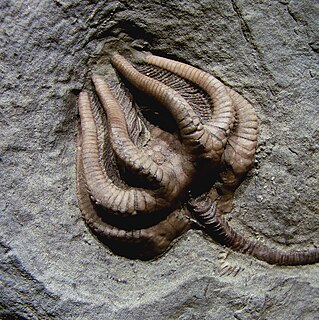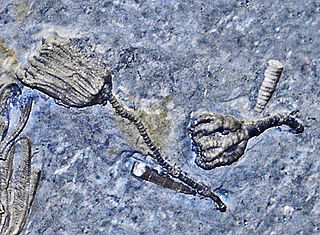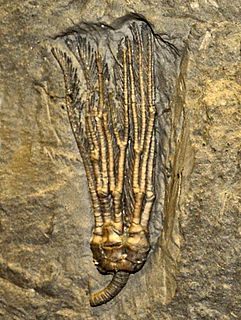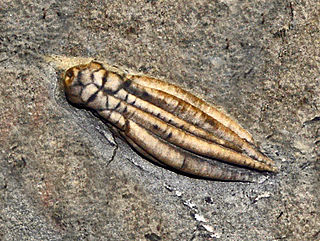Related Research Articles

Crinoids are marine animals that make up the class Crinoidea, one of the classes of the phylum Echinodermata, which also includes the starfish, brittle stars, sea urchins and sea cucumbers. Those crinoids which, in their adult form, are attached to the sea bottom by a stalk are commonly called sea lilies, while the unstalked forms are called feather stars or comatulids, being members of the largest crinoid order, Comatulida.
A. elegans may refer to:
S. elegans may refer to:

Allogalathea elegans is a species of squat lobster that is sometimes kept in marine aquariums. Despite their common name, they are more closely related to hermit crabs than lobsters.

Agaricocrinus americanus, the mushroom crinoid, is a species of extinct crinoid, known only from its fossils, which are found in the U.S. states of Indiana, Tennessee and Kentucky. They date back to the Lower Mississippian, about 345 million years ago.

The Kimmswick Limestone is an Ordovician geologic formation in Arkansas, Illinois and Missouri. Fossils occurring in the Kimmswick include corals, bryozoans, brachiopods, conodonts, trilobites, crinoids and mollusks.

Scyphocrinus, is an extinct genus of crinoids. Species belonging to this genus lived during the Silurian and Devonian periods.

Taxocrinus is an extinct genus of crinoids.

Abrotocrinus is an extinct genus of crinoids.

Scytalocrinus is an extinct genus of crinoids.

Ulrichicrinus is an extinct genus of crinoids.

Comatulidae is a family of comatulid crinoids. Since 2015, it replaces the family Comasteridae.
Clarkometra elegans is a species of feather star, a type of crinoid, in the family Colobometridae. It is found from South West Mindanao in the Philippines to the Bonin Islands, Japan. It occurs at a depth ranging from 72 to 80 m.
The following are lists of prehistoric animals:
References
- ↑ Fossils in the Oxford University Museum.—II. On Two New Genera and Species of Crinoidea (Brahmacrinus ponderosus and Cicerocrinus elegans). WJ Sollas, Quarterly Journal of the Geological Society, 1900